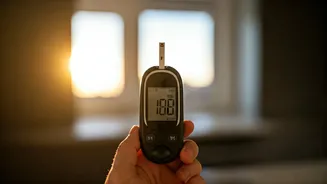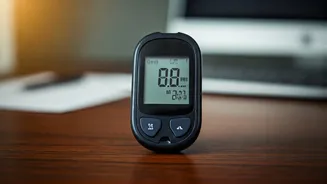The Dawn Effect
The dawn phenomenon describes a natural surge in blood sugar levels that typically occurs between 2:00 AM and 8:00 AM. This rise is primarily due to hormonal
changes. The body releases hormones like growth hormone, cortisol, glucagon, and adrenaline during this time to prepare for the day. These hormones counteract insulin, leading to increased blood sugar. The liver also contributes by releasing stored glucose into the bloodstream. While this is a normal process, it can be problematic for individuals with diabetes, as their bodies may not produce enough insulin or respond to it effectively, resulting in higher morning blood sugar levels. Understanding this phenomenon is vital for better diabetes management.
Risk Factor Insights
Several factors can increase the likelihood of experiencing elevated morning blood sugar. For instance, individuals with type 1 or type 2 diabetes are at higher risk because their bodies struggle to regulate blood sugar effectively. Insulin resistance, a condition where cells do not respond properly to insulin, is another significant factor. Poorly controlled diabetes, where blood sugar levels are consistently high, also worsens the dawn phenomenon. Other contributors include inadequate insulin doses, which may not cover the overnight increase in blood sugar, or consuming high-carbohydrate meals before bed. Sleep apnea, a condition where breathing repeatedly stops and starts during sleep, has also been linked to morning blood sugar spikes. Moreover, hormonal imbalances and certain medications can play a role.
Effective Management Strategies
Managing elevated morning blood sugar involves a multifaceted approach. Dietary adjustments are crucial; focusing on balanced meals with controlled carbohydrate intake in the evening can help. Regular exercise is beneficial because it improves insulin sensitivity, making the body more efficient at using insulin. Timing of insulin doses may need to be adjusted; some individuals may require a higher dose of long-acting insulin before bed to cover the dawn phenomenon. Additionally, the use of continuous glucose monitoring (CGM) can provide valuable insights into blood sugar patterns, helping to tailor treatment plans. Addressing underlying conditions like sleep apnea or any other health issues, under the guidance of a healthcare professional, is essential. Regular monitoring and communication with healthcare providers are key to successful management.
Lifestyle Adjustments
In addition to medical treatments, certain lifestyle changes can significantly impact morning blood sugar. Consistency in meal times helps regulate blood sugar levels. Avoiding late-night snacks, especially those high in carbohydrates, is advisable. Maintaining a consistent sleep schedule can also be beneficial, as it regulates hormone levels. Regular physical activity, such as a brisk walk or any other exercise, can enhance insulin sensitivity. Monitoring blood sugar levels regularly, both fasting and post-meal, offers valuable data for fine-tuning treatment. Individuals should also collaborate closely with their healthcare team to adjust medication dosages and lifestyle habits. These combined strategies are crucial for effectively managing the dawn phenomenon and promoting overall health.
When to Seek Advice
Consulting a healthcare professional is crucial if you consistently experience elevated morning blood sugar levels. They can help diagnose the underlying cause and develop a tailored management plan. If you notice any unusual symptoms, such as increased thirst, frequent urination, fatigue, or blurred vision, it's essential to seek medical advice promptly. A healthcare provider can perform the necessary tests, such as a fasting blood glucose test or an A1c test, to assess your blood sugar control. They can also review your medications, diet, and exercise habits to identify areas for improvement. Regular check-ups and open communication with your healthcare team are key to effectively managing the dawn phenomenon and maintaining optimal health.














